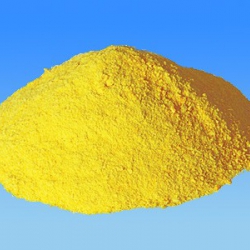Product introduction: Polyaluminium chloride referred to as PAC, also known as basic polyaluminum chloride or coagulant, it is a water-soluble inorganic high molecular polymer between AlCl3 and Al(OH)3. It has strong bridging adsorption performance, and it is accompanied by physical and chemical processes such as coagulation, adsorption and sedimentation during the hydrolysis process. Compared with other coagulants, it has the advantages of wide adaptability to water, wide application range, good sedimentation performance, wide pH range, and small change in pH value of water after treatment.
Mechanism of action: The main form of polyaluminium chloride in water is AL13O4(OH)247+, and its coagulation mechanism is mainly reflected in the following three aspects: a. Strong neutralization of colloidal substances in water; b. Hydrolyzed products Excellent bridging adsorption of suspended solids in water; c. Selective adsorption of dissolved substances.
Scope of application: It is suitable for the special water treatment of drinking water and water supply, iron removal, cadmium removal, fluorine removal, and oil slick removal. It is also suitable for industrial wastewater treatment, such as printing and dyeing wastewater, and is widely used in papermaking, medicine, and leather making.
High-efficiency flocculant
Application range:
The high-efficiency flocculant is mainly used for the treatment of wastewater, and is suitable for the treatment of soluble wastewater such as active and acidic. It can also be used in the treatment of wastewater such as textile, chemical, coking, papermaking, printing and dyeing, bleaching and dyeing, leather, urban sewage, industrial sewage stations. Can replace water, activated carbon, polyacrylamide and other agents.
Performance:
1. The high-efficiency flocculant is easily dissolved in water, and a multi-nuclear complex can be formed to polymerize and grow the granular colloid and the particulate suspended matter in the water to form a floc with large volume, high density and rapid sedimentation.
2. In the water treatment, the high-efficiency flocculant has a wide application range (pH 7.5 to 10) for the pH of the raw water, and is most suitable for slightly alkaline.
3. The high-efficiency flocculant has no corrosive effect on pipeline equipment, and has high chroma, SS, COD and BOD removal rates. The treated wastewater can meet national emission standards and provide final water reuse.
4. The high-efficiency flocculant has no suspended solids or sediment, does not block the dosing equipment and pipelines, and can be directly added to the raw liquid for wastewater treatment without secondary pollution.
5. The high-efficiency flocculant produces a large density of flocs, is easily soluble in water, and has less sludge.
6. The high-efficiency flocculant is anionic, cationic and non-ionic, and can be targeted for various wastewater treatments.
The working principle of flocculant:
The flocculation precipitation method uses an inorganic flocculant (such as aluminum sulfate) and an organic anionic flocculant polyacrylamide (PAM) to form an aqueous solution into the wastewater, which will produce a compressed electric double layer, which will make the suspended particles in the wastewater lose stability. The colloidal particles agglomerate each other to increase the particles, forming flocs and silk flowers. After the floc grows to a certain volume, it is separated from the aqueous phase by gravity, thereby removing a large amount of suspended matter in the wastewater, thereby achieving the effect of water treatment. In order to improve the separation effect, a coagulant may be added in a timely and appropriate amount. The treated sewage can basically reach the discharge standard in terms of color, chromium content, suspended matter content, etc., and can be discharged or used as refill water for artificial water injection and oil recovery.
Application of flocculant:
1. Urban sewage:
The treatment of domestic sewage with high-efficiency mixed bacteria with flocculation and degradation separated from urban domestic sewage can make the removal rate of COD and BOD of sewage reach 100%1.
2. Building materials wastewater:
Wastewater for building materials containing high suspended solids is also a kind of wastewater that is difficult to treat. For example, ceramic wastewater, mainly including embryo body wastewater and glaze wastewater, the former mainly contains more clay particles, and the latter contains clay particles. In addition, there is a considerable amount of glaze. 5 minutes after the addition of NOC-1, the turbidity of the embryo body wastewater was reduced from the original 1.4 to 0.043; the turbidity of the glaze wastewater decreased from 17.2 to 0.35; the turbidity removal rates were 96.6% and 97.9%, respectively, which was almost transparent. The supernatant. The plant wastewater was treated with a flocculant produced by Rhodococcus erythropolis, and the treated supernatant was almost transparent.
3. Other applications:
Because the water treatment flocculant has safe and non-toxic properties, it is gradually adopted in the treatment of food wastewater, and has achieved satisfactory results.
In addition, microbial flocculants can be widely used in many aspects of urban sewage, hospital sewage, petrochemical wastewater, papermaking waste liquid, pharmaceutical wastewater.
In summary, the development of flocculants is from low molecular to high molecular, inorganic to organic and microbial, and single to complex. The pursuit of high efficiency, low cost, environmental protection is the goal of the development of flocculants, targeted development of non-toxic or low-toxic high-efficiency flocculants, so that the biological toxicity and residuals in drinking water and other water treatment related to human activities no longer cause Two times of pollution is an important direction for the development of flocculant research in the future.
Secondly, the quantitative research on the flocculation effect and the reduction of production cost are the most urgent tasks for the development of new flocculants. Driven by both theory and practice, safe, non-toxic and efficient water treatment flocculants have a tendency to replace traditional flocculants. Inorganic and organic polymer composite flocculants are also obtained at home and abroad due to the combination of inorganic and organic advantages. Extensive development has become a hot spot in flocculant research


